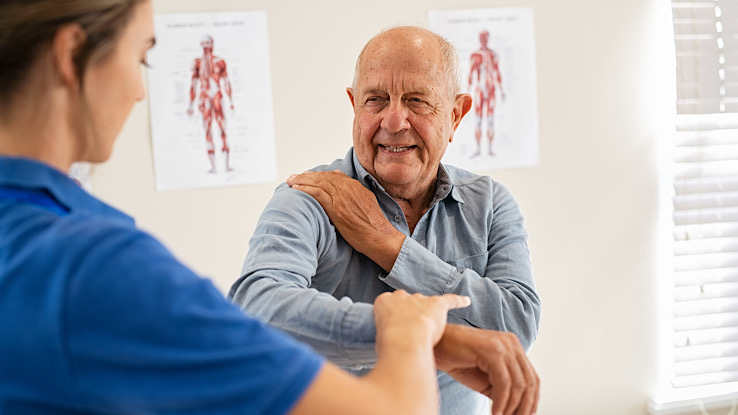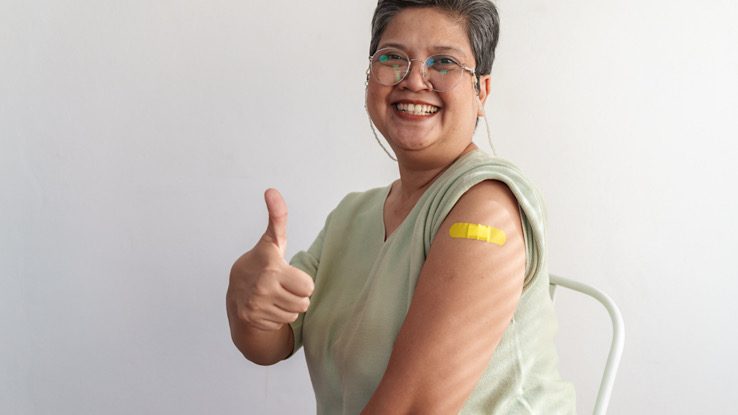
Shingles is common in the United States. About 1 million adults are diagnosed with shingles every year. If you’ve had chickenpox in the past, you are at risk for shingles. Continue reading to learn more about the signs and symptoms of shingles, the treatment options, and how you can prevent shingles.
What Causes Shingles?
Do you remember people at your school or neighborhood getting chickenpox? If you had chickenpox yourself, you probably remember the really itchy red bumps that covered your body. Luckily, getting chickenpox more than once in a lifetime is rare, thanks to your immune system’s memory of the virus.
Unfortunately, after you get better from chickenpox, the virus that causes chickenpox can remain in your body for many years. The virus hides quietly in the nerves that control sensation in your skin. Years to decades later, the virus can reactivate and cause shingles (also known as herpes zoster).
How Shingles Differ From Chickenpox
Although the same virus causes both illnesses, there are a few differences between shingles and chickenpox like:
- The age you may get the illness: Shingles often affects older adults, while chickenpox usually happens in childhood.
- The symptoms you may have: Chickenpox often begins with flu-like symptoms before causing itchy, red rashes all over the body. Shingles, however, typically causes a painful rash in a single area.
- What may cause it to happen: Shingles is more likely to happen during stressful times and as you get older. Both stress and aging can weaken your immune system so it makes it easier for the virus to reactivate and cause shingles.
- Spreading the illness to other people: Chickenpox is highly contagious, while shingles is not as easy to spread. But, people who have never had chickenpox or were not vaccinated against chickenpox may get chickenpox from direct contact with someone with shingles. Also, people who are vaccinated against chickenpox are much less likely to get shingles.
What Are the Signs and Symptoms of Shingles?

The most common sign of shingles is a painful rash. A few days before a rash appears, you may notice some skin-related indicators and flu-like symptoms. This could be a warning for a shingles episode. These symptoms may include:
- Skin tingling, shooting pain, or numbness
- Itching sensations
- Fever or chills
- Headache
- Upset stomach
- Fatigue
If you have a rash, it typically appears as a reddish stripe of small red bumps on one side of the body. The rash may have blisters which can be filled with fluid. These blisters can also burst and form a scab over the course of a few weeks. The rash can happen on different areas of your body, but it most often appears on the chest, back, or abdomen. You may also have a rash on the legs, head, neck or arms. In rare cases you may have rashes on the buttocks, face, ears, eyes or eyelids. It is important to see your doctor immediately if you have a rash on your eyes or eyelids.
Shingles Symptoms in the Eye
A shingles infection involving the eye is a medical emergency. Without early treatment, it can lead to permanent blindness. Shingles usually affects just one eye. Symptoms of shingles in the eye include:
- Eye pain and redness
- Painful rash around the eye
- Watery eyes that drain fluid
- Itching or throbbing around the eye
- Blurry vision
- Sensitivity to light
If you notice any of these symptoms or you have a shingles rash near your eye (on your face, scalp or eyelids), go to your doctor or the nearest emergency room right away.
You may also have pain in the same area as your rash. Some people have minor itching or burning, while others report severe pain. The pain can get worse with touch, clothing, wind, and temperature changes. The pain tends to peak after about a week, and then will likely start to get better.
However, in some cases of shingles, the pain can continue for long periods after the infection (also known as postherpetic neuralgia). The risk of postherpetic neuralgia increases with older age. Talk to your doctor if your pain is lasting longer than normal.
Episodes of shingles typically last 3 to 5 weeks. If you are having symptoms that you think could be a shingles infection, see your doctor as soon as possible.
What Are the Treatments for Shingles?
There are several treatments that can help if you have shingles. The treatment can help to:
- Get you better faster
- Treat your symptoms such as pain or itching
- Heal your rash
- Decrease your chances of having postherpetic neuralgia.
Antivirals
If you have shingles, your doctor may recommend antivirals like acyclovir, valacyclovir, and famciclovir. This is usually a pill that can help stop your shingles from getting worse. Antivirals work best if you begin taking them within three days of your first symptoms. So, if you think you may have shingles, see your doctor right away.
Pain Medication
If you are having pain, your doctor may also recommend pain medications to help.
For mild to moderate pain you may have:
- Over-the-counter pain relievers like ibuprofen
- Topical patches/ointments like lidocaine patches
For severe or persistent pain, prescription medications may be necessary like:
- Nerve-type pain inhibitors
- Steroids
- Antidepressants
- Opioid pain medication
- Stronger topical creams/patches.
Some home remedies can also help ease the painful sensations of shingles. But it is important to see your doctor. These home remedies can include:
- Oatmeal baths
- Cool compresses
- Gentle exercise
- Wearing loose and soft clothing that irritates the rash less
How Can I Prevent Shingles?

The best way you can prevent shingles is to get the shingles vaccine called Shingrix. The shingles vaccine works very well to prevent shingles. It also reduces your chances of having persistent pain if you were to get shingles.
Everyone ages 50 and older are recommended to get two doses of the shingles vaccine. Even if you’ve already had shingles, you can still get the vaccine to prevent it from happening again.
If you’re 50 or older, talk with your doctor about getting vaccinated for shingles.
Resource Links:
- “Shingles” via Mayo Clinic
- “Treating Shingles (Herpes Zoster)” via Centers for Disease Control and Prevention
- “Shingles Vaccination” via Centers for Disease Control and Prevention
- “Shingles” via National Institute on Aging
- “Shingles: Overview” via American Academy of Dermatology
- “Shingles” via Johns Hopkins Medicine
- “Study: Children vaccinated against varicella less likely to get herpes zoster” via American Academy of Pediatrics
- “Herpes Zoster” via The Biomedical Journal
- “Herpes Zoster” via The New England Journal of Medicine
- “Evaluation and Management of Herpes Zoster Ophthalmicus” via The American Academy of Family Physicians
- “Herpes Zoster (Shingles) of the Eye” via University of Michigan Health
- “Shingles of the eye can cause lasting vision impairment” via Harvard Health





